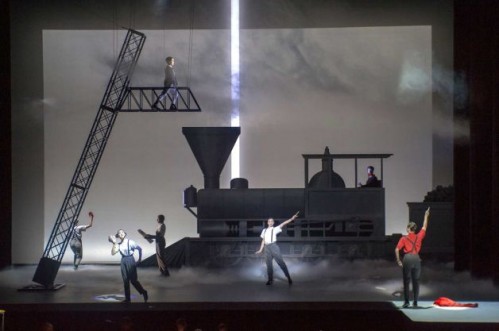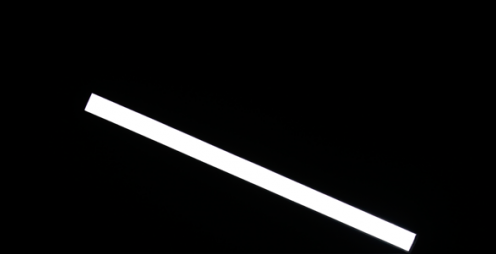This simple declaration of setting—space; time—comes about a quarter of the way into Einstein on the Beach, the 1976 opera by Philip Glass and Robert Wilson currently in revival on a world tour. The brief spoken passage is one of the few, if not the only, that is unaccompanied by music. (Actually, the line in the revival is “Bern, Switzerland. 1905,” but I prefer the original for its abruptness.) The line is immediately followed by a frenetic 13-minute ballet in which ten dancers, always at nothing less than a gallop, trace and retrace geometric patterns with slight variations. As I watched their exertions during a recent matinee at the Brooklyn Academy of Music, I thought, “What they’re doing is superhuman.”
And then I thought, “And yet they’re human.”
Not that the word superhuman implies doing something that humans can’t do. But it does imply doing something that humans don’t do—at least not without pushing themselves beyond what we otherwise think that humans can do.
Which, I realized with a start, is what Einstein did in Bern in 1905.
 Over four months, March through June 1905, Einstein produced four papers that revolutionized science. One explained how to measure the size of molecules in a liquid, and another posited how to determine their movement (Brownian motion)—two papers that together made a strong case for the existence of the atom. A third described how light comes in packets—the foundation of quantum physics as well as the idea that eventually won him the Nobel Prize. A fourth paper introduced the special theory of relativity, leading physicists to reconsider notions of space and time that had sufficed since the dawn of civilization. Then, a few months later, more as an afterthought than an encore, Einstein pointed out in a fifth paper that matter and energy can be interchangeable at the atomic level—specifically, that E=mc↑2.
Over four months, March through June 1905, Einstein produced four papers that revolutionized science. One explained how to measure the size of molecules in a liquid, and another posited how to determine their movement (Brownian motion)—two papers that together made a strong case for the existence of the atom. A third described how light comes in packets—the foundation of quantum physics as well as the idea that eventually won him the Nobel Prize. A fourth paper introduced the special theory of relativity, leading physicists to reconsider notions of space and time that had sufficed since the dawn of civilization. Then, a few months later, more as an afterthought than an encore, Einstein pointed out in a fifth paper that matter and energy can be interchangeable at the atomic level—specifically, that E=mc↑2.
The opera is hardly biographical. It’s barely about—to the extent that it’s about anything—Einstein. But allusions to Einstein’s life and science often appear, and they do appear in chronological order.
Early in the work a boy tosses paper airplanes. Late in the opera the iconographic Einstein—think white fright wig—sits in a spotlit chair next to the orchestra pit, solemnly sawing away at his violin. Along the way we encounter the trains and elevators of his thought experiments, the compasses and clocks that inspired those flights of insight, an eclipse or two, an orchestral crescendo evoking a nuclear blast, and, repeatedly, the central image of the opera: a beam of light. Only, in an inspired pun, it is a beam of light in the sense that it looks like an architectural beam that is made of light.
But what we can’t help think about is the superhuman effort and achievement. The dancers mapping choreographer Lucinda Childs’s visual representation of the curlicues and repetitions and variations of the score. The members of the orchestra and chorus who navigate the intricacies of that musical labyrinth. The two women, sitting at desks downstage left, who make (scripted) cryptic motions with their hands while speaking (scripted) cryptic nonsense and numbers, for fifteen minutes before the performance formally begins. The chorus members who stand completely still, staring off into far corners of the auditorium, for (depending on their entrance) five or ten minutes before the performance formally begins. The poor guy who has to mime “reading” a book by moving his head rapidly back and forth for five or ten minutes at a stretch in several scenes. The various actors who must enact simple movements—filing into a jury box, for instance, or producing a gun—in elaborately incremental slow motion.
And us! The members of the audience. The opera is well over four hours long, without an intermission. Although the program encourages us to leave and enter as we wish, for the most part we don’t. (I was sitting near the end of a row, and nobody nudged past me.) And why would we? Who wouldn’t want to be superhuman for four-plus hours? Being superhuman over a period of time is practically the definition of stamina. The opera is a test of endurance, but it’s endurance in a good way. The exertions of the bodies—theirs, on stage and in or next to the pit, and ours—mimic the exertions of the mind.
I don’t know if this train of thought is what the authors intended with their thoughts of trains. Nor do I think it matters—not in a theatrical piece in which the audience can come and go as it pleases. But it’s where my train went, and that destination is good enough for me (and, I suspect, the authors—precisely because their intention was to cultivate ambiguity as an end in itself).
After Einstein posted the last of his four papers—the one on special relativity—in June 1905, in Bern (Switzerland), he took to bed for several days.
Having experienced Einstein on the Beach, we know the feeling.

One thought on “A Day at the Opera”
Comments are closed.